Anklam is the name of one of the smaller North German Hanseatic cities. It is a small town with an exciting history and fine sights, which can be seen on some lovely walks in the town centre. The best place to start is the main square Markt.
There are some large churches and fine houses in the city streets. The modern history goes back to the 13th century, when trade flourished in the region, and as a visible result, Anklam’s harbor was built. Fish and other goods made the economy grow, and there was corresponding growth in the city.
Throughout the 13th and 14th centuries, Anklam’s large churches were built. Both the Marienkirche and the Nikolaikirche from this time are still some of the city’s biggest and most beautiful sights. You can also see preserved parts of the city’s defenses from the Middle Ages, and there is also an interesting museum about the aviation pioneer Otto Lilienthal.
Anklam is not the only Hanseatic city in the area, so there are good opportunities for exciting trips to, for example, Greifswald and Demmin, but also to the somewhat larger city of Stralsund. You can also take trips to the lovely beaches of the Baltic Sea or visit other of the region’s cozy towns.
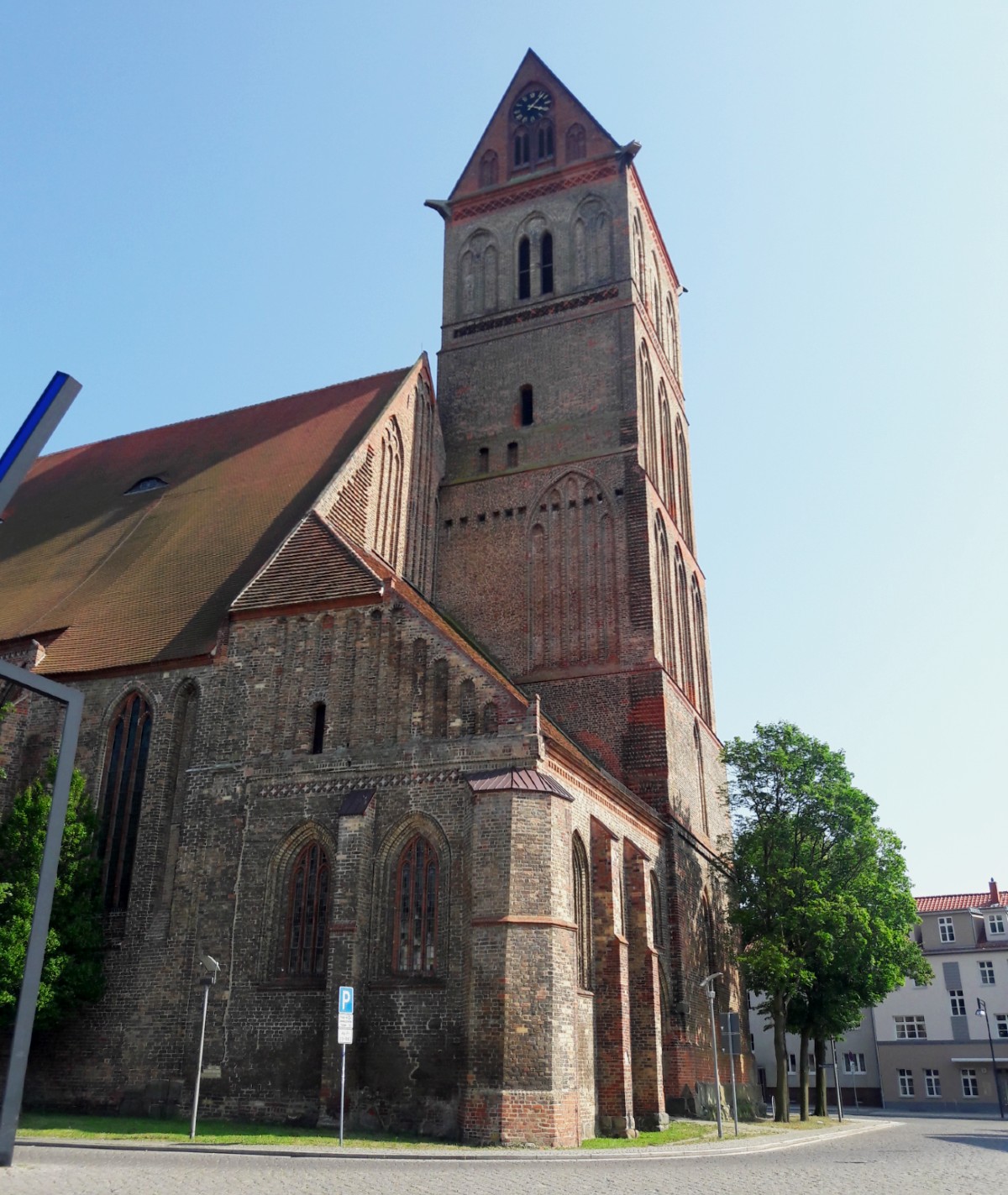
Marienkirche is one of Anklam’s two large old churches. Construction started in the middle of the 13th century with the dedication of the church in 1296. The early church was Romanesque in style, which can be seen at the tower in the otherwise mainly Gothic church, which belongs to the great North German brick Gothic constructions.
The Gothic church arose in the 1300s and 1400s, and one of the architectural models was Lübeck’s Marienkirche. The plans were for a double-towered church complex like in Lübeck, but only one tower was built; later a chapel was established on the site intended for the planned but unbuilt tower.
The church is a three-aisled hall church with a late Romanesque choir. The nave, choir and nave are under a large gabled roof. The tower’s height has varied over time with several rebuilds in the 19th century, when the tower reached a height of approximately 100 metres. After destruction in connection with the Second World War, the reconstructed tower was given the current 66 meters.
The church is worth seeing on the outside, but it is in the interior that the greatest attraction is revealed. In 1936-1937, the church’s wall paintings from the 14th century were exposed, and they differed from other similar decorations in Northern Germany by covering large parts of the space, which gave a great overall impression. In addition to the paintings, you can see the church’s baptismal font from around 1330. Other original parts from the church’s interior were largely destroyed in WWII, where they were stored at Schwerinsburg, which burned.
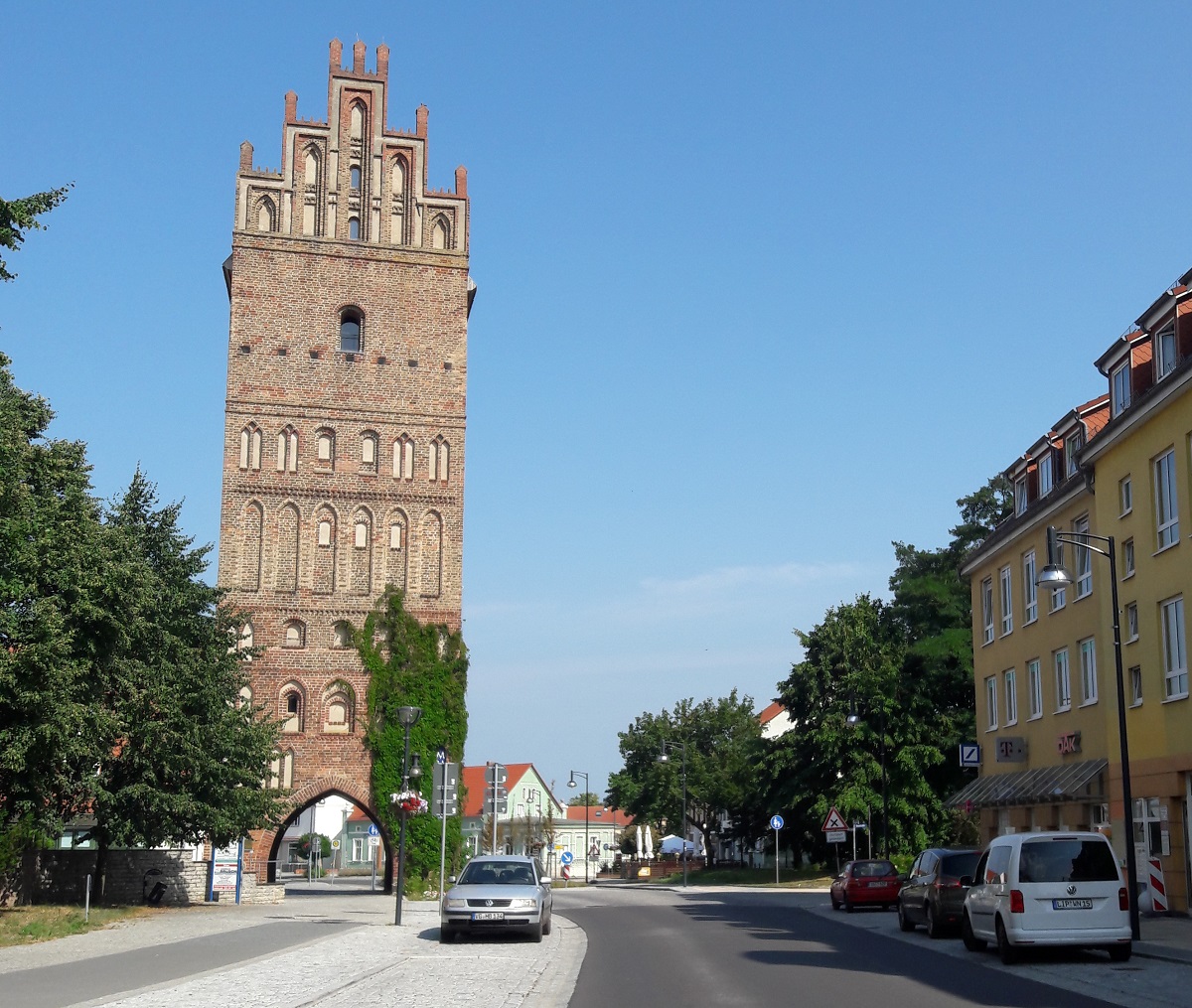
Steintor is one of Anklam’s historic city gates, and at 32 meters it is also the highest preserved city gate in the region of Pomerania. The gate was built in the 13th century and is believed to have reached its current height around 1250.
There were originally six city gates in Anklam’s medieval fortifications, which was a complex of city walls, city gates and fortress towers. Since 1846, Steintor has been the only preserved of these gates. Stolper Tor was demolished that year to make room for increased traffic to the city.
In 1927, a cultural history museum was established in Anklam, and after various locations it was set up as the Museum in Steintor in 1989. At the museum you can experience local history from Anklam and regional history from the Peenetal area. You can also see various depictions from the Hanseatic period and collections of art and more.
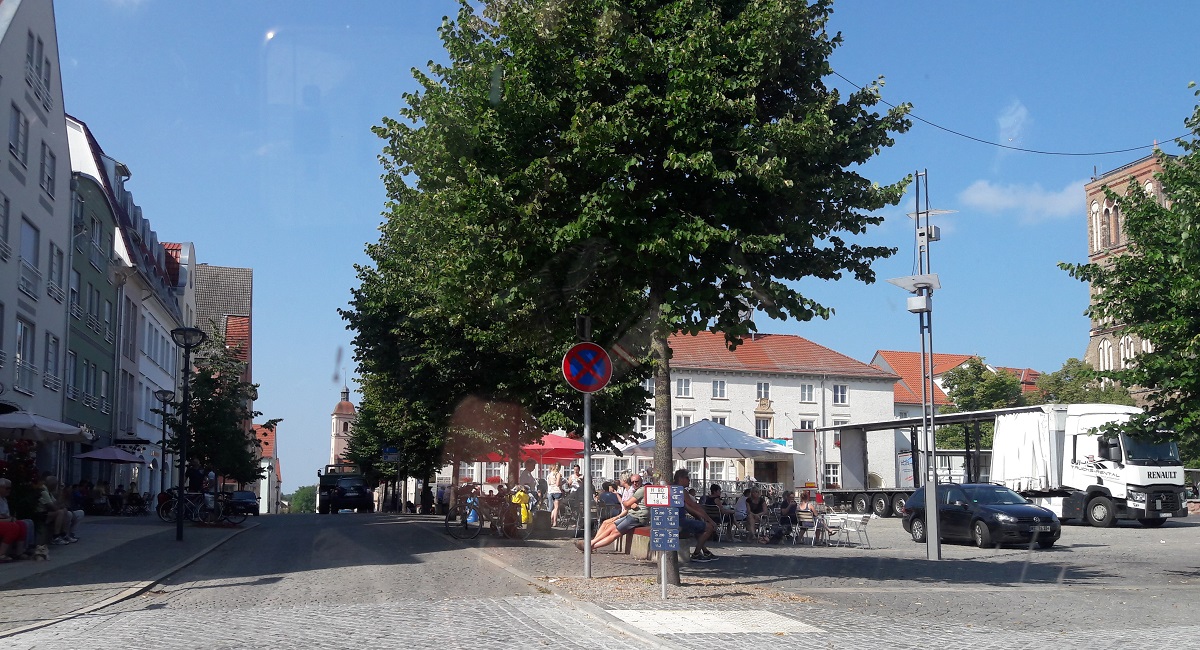
Markt is the market square and center of Anklam, and since the city’s foundation it has been the city’s marketplace and the seat of the city’s government. The town was founded in 1243, and Markt was established no later than in the 1260s. The city’s Gothic town hall was built on the square, and over time many of the gabled houses so typical of the Hanseatic cities were also built around Markt.
In 1525, the Gothic town hall burned down, but was rebuilt. The town hall stood until 1842, when it was demolished, and the rest of the square has also suffered a lot of damage since then, not least in connection with the Second World War battles.
Today, Markt is still the center of the city, but the appearance of the square has radically changed since the Hanseatic period or simply the beginning of the 20th century. The city’s town hall is still located here; it is a modern building on the north side of the square, and it was built in 1950-1952. During the GDR era, other houses were also built, which have subsequently been demolished to make room for new buildings, which are stylistically inspired by Anklam’s historic buildings around the Markt.
Pulverturm is a preserved fortress tower from Anklam’s medieval city walls and fortifications. The tower was completed in the middle of the 15th century, at a time when Anklam was in feud with Schwerin’s noble family. The Pulverturm was an important tower, as it stood between the city gates Steintor and Stolper Tor as the only tall fortification. The gate originally had a pointed tower hat.
During the battles of the Thirty Years’ War, the Pulverturm was destroyed, but subsequently rebuilt. From the 15th-16th centuries, the tower was set up as a prison and later used as a gunpowder magazine, which gave it its current name. Between 1860 and 1874 the astronomer Gustav Spörer used the Pulverturm as an observatory, and one of the students was the later so famous Otto Lilienthal.
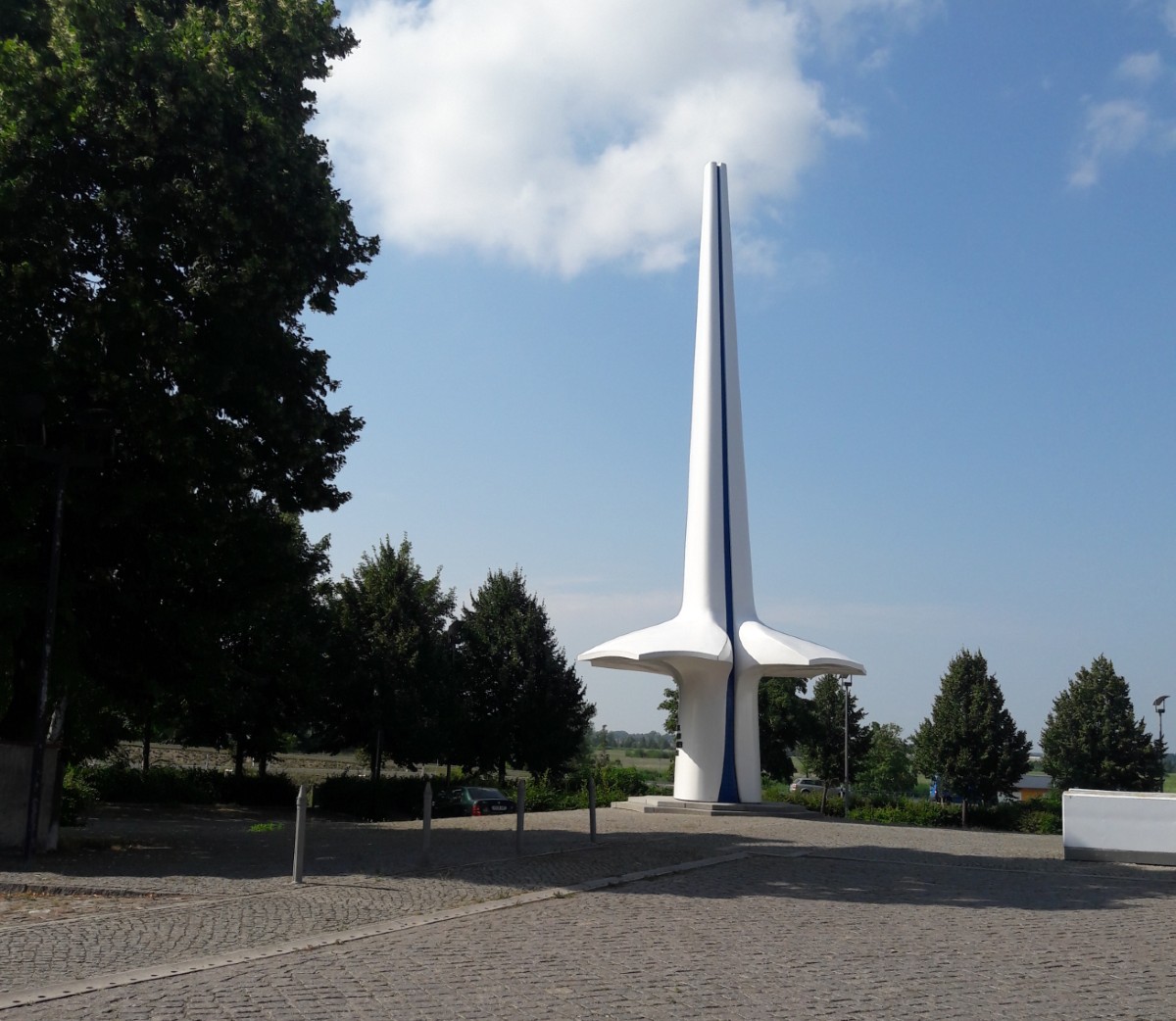
Otto Lilienthal is the name of Anklam’s probably most famous citizen. He was born in Anklam on 23 May 1848 and became a pilot and aviation pioneer. Lilienthal conducted more than 2,000 experiments with gliding, and his experiments were a major contribution to the understanding of the basic principles of flight. Lilienthal died in Berlin in 1896 during one of his experiments with a glider.
Since 1927, there have been exhibitions in Anklam that have told the story of Otto Lilienthal’s life and achievements. The current museum opened in 1991, and you can see reconstructions and overviews of all known constructions from Lilienthal’s hand in the permanent exhibition.
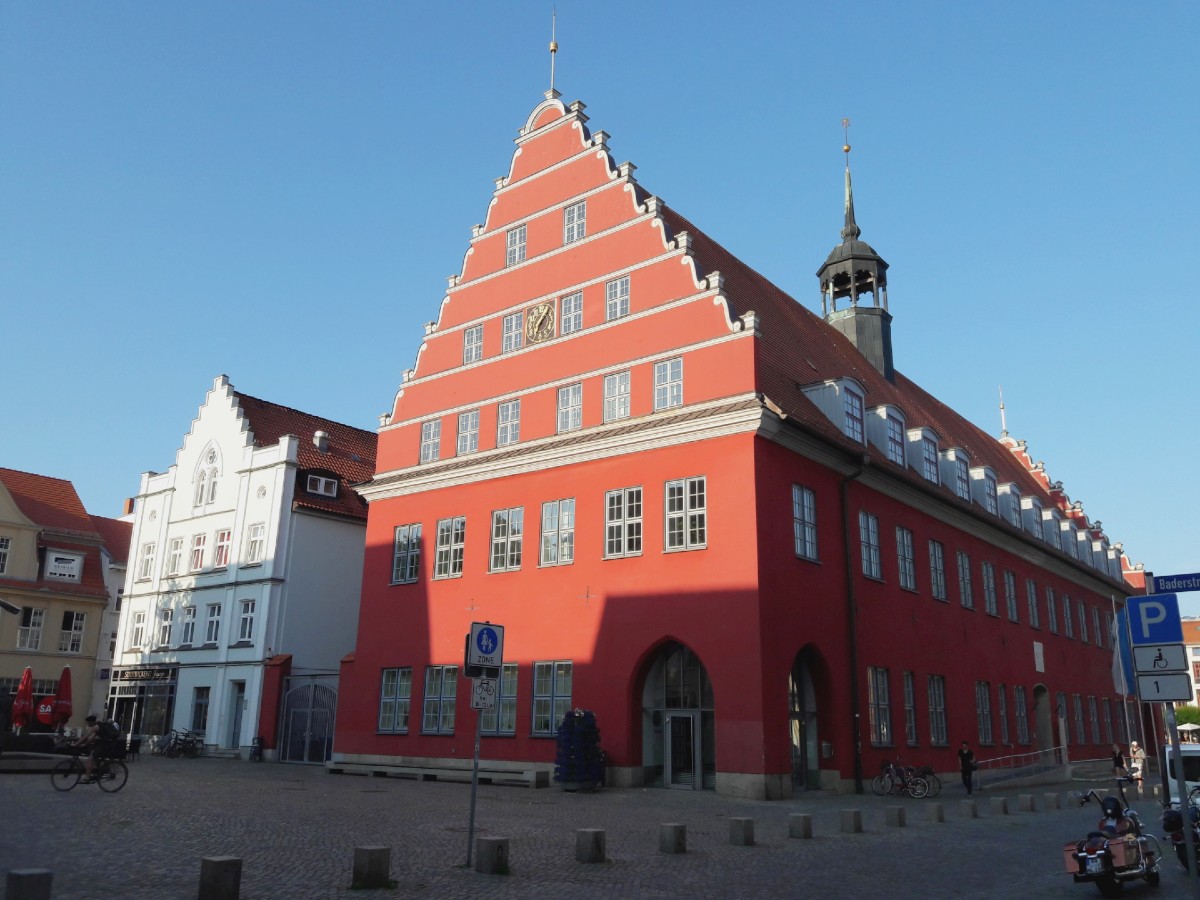
The Hanseatic city of Greifswald by the river Ryck is a cozy and interesting city with everything that belongs to the epitome of a northern German city. Beautiful buildings, impressive churches, a central market square and a town hall with a history from the Hanseatic period are just some of the highlights.
Compared to other northern German Hanseatic cities, Greifswald is a relatively small town, and this gives the opportunity to experience the city on foot at your leisure. There is not far between the sights, which for many is a great experience.
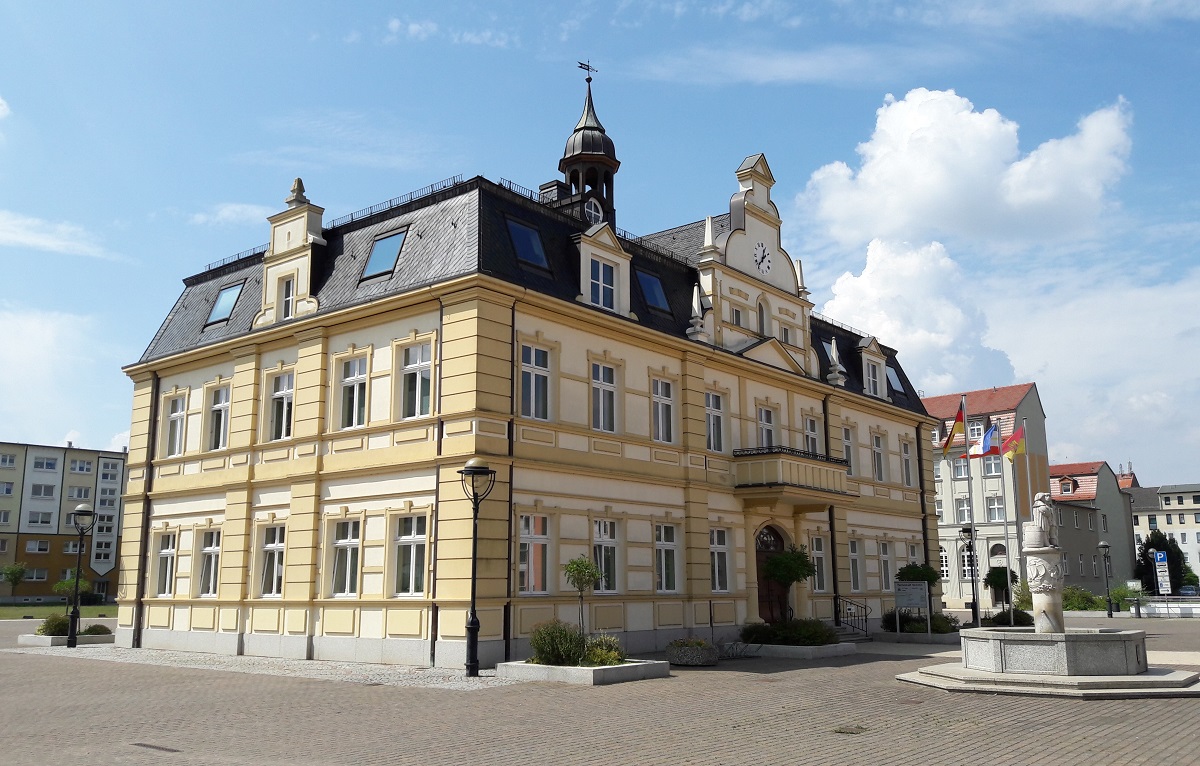
The town of Demmin is one of Mecklenburg-Western Pomerania’s Hanseatic cities, and there are several sights in the town from its history as a fortified trading post. Today, slightly more than 10,000 inhabitants live in Demmin, where Markt forms the central square and town centre.
The square is the city’s marketplace, and it is a good starting point for a stroll in the city. Take a look at the elegant Town Hall before the walk passes the church of St.-Bartholomaei-Kirche and the maritime environment of the city’s once-bustling river port, which has contributed to a great deal of Demmin’s growth.
Stralsund is a Hanseatic city and one of the region’s larger cities with a cozy old quarter with many attractions. Stralsund’s rich history as a flourishing Hanseatic city can be seen everywhere. Merchant buildings line the streets between the city’s three large churches and other public buildings that were constructed as symbols of the city’s wealth in the medieval Hanseatic period.
The many small streets are atmospheric as if from a bygone era, and you quickly discover why the city center has made it onto UNESCO’s list of world cultural heritage. Squares and the area by the water are other very lively places where larger events often take place.
Stralsund’s location with water on all sides offers opportunities for many wonderful activities, either directly on the water or at one of the city’s distinguished maritime museums with the modern aquarium, Ozeaneum, as the spearhead.
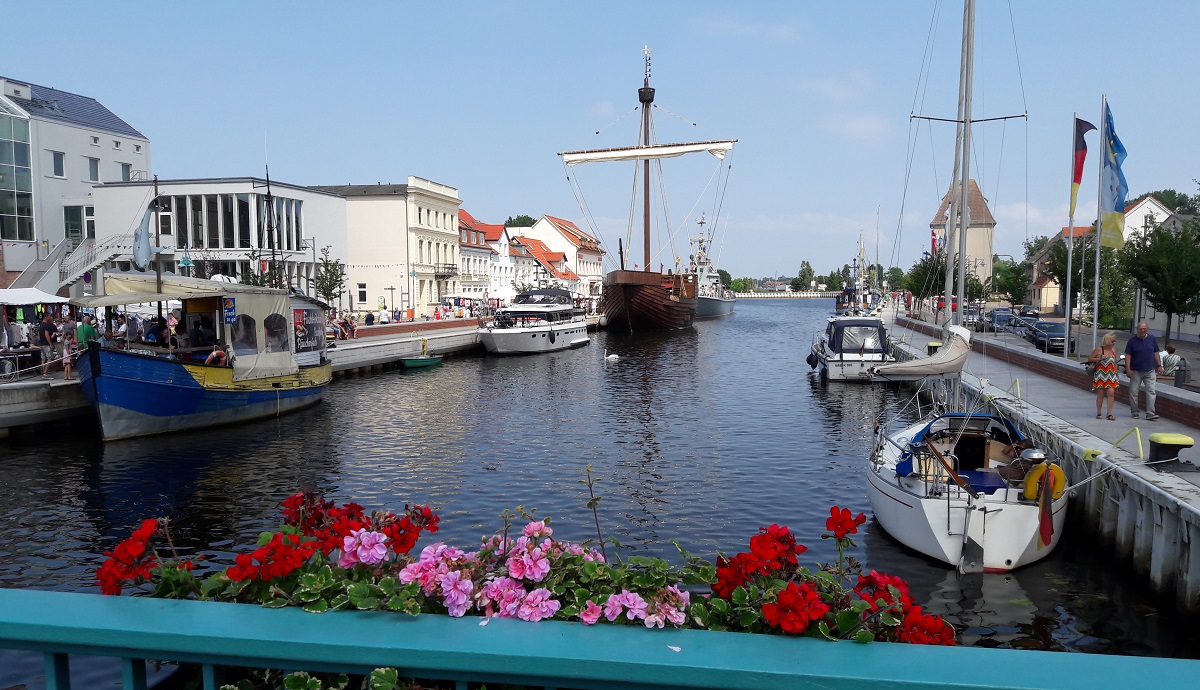
Ueckermünde is a harbor town at the mouth of the river Uecker, and the combination of the maritime with a very pleasant town center makes a trip here a pleasant experience in northeastern Germany.
Historically, Ueckermünde was first mentioned in 1178 and it was a fishing town. In the following centuries, the city grew due to trade and its favorable location on the Uecker, and several larger buildings were constructed like the fortified castle that the dukes of Pomerania had built, churches and fortifications.
Today, many people visit Ueckermünde to take a walk around the charming harbor along the Uecker (Altes Bollwerk, Neues Bollwerk), which is close to the old town. Here is a market and several different options for sailing trips or visits to ships during the season.
However, you should include a trip in the city center northwest of the harbour. Here you can see the preserved parts of the ducal palace (Am Rathaus) from the 1540s, which is today the seat of the city’s administration, and the Marienkirche church (Ueckerstraße 86), which is particularly worth seeing.
Marienkirche in its current version was built in the years 1752-1766 in baroque and rococo architecture; however, with a neo-Gothic tower from 1866. It is the interior of the church that is something special. The interior with balconies and the painted flat wooden ceiling create a special space and atmosphere.
Finally, you can walk about a hundred meters further north-west from the church, where the town square named Markt is located. Markt is surrounded by a number of fine buildings, and there is outdoor seating at the square during the season and a fountain.
The Historisch-Technisches Museum Peenemünde is a museum that was established in 1991 in the former power plant building of the city of Peenemünde. The museum’s primary focus is the German rocket tests and construction that took place around Peenemünde in the period 1936-1945. It was here that Wernher von Braun headed the Nazi rocket program, probably best known for the V1 and V2 rockets.
Wernher von Braun experimented with rockets for many years, and after the end of World War II he continued to work for the United States. His efforts and knowledge ended up being the Saturn V rockets that carried American astronauts into space and to the Moon.
The test facilities at Peenemünde were made possible in 1936 when the Ministry of Aviation in Germany bought the northern part of the island of Usedom from the town of Wolgast for 750,000 reichsmarks. After this, an extensive complex of buildings was built, where rockets and so on were tested. Peenemünde was bombed several times during World War II, with the first raid on the 17th and 18th August 1943.
At the museum, there are also other depictions and objects exhibited than von Braun’s rockets. These include, for example, a corvette from the GDR’s Volksmarine, Russian MIG aircraft and railway equipment. All in all, the place is an experience for both those interested in history and technology.
Lomonossowallee 58, Greifswald
moewencenter.de
Rigaer Straße 9, Greifswald
oez-greifswald.com
Lange Straße, Greifswald
Markt, Steinstraße, Frauenstraße
HanseDom
Grünhufer Bogen 18-20, Stralsund
hansedom.de
Heimattierpark
Anlagen 3, Greifswald
tierpark-greifswald.de
Ozeaneum
Hafenstraße 11, Stralsund
ozeaneum.de
Anklam’s history goes back to its first term in 1243; then called Tachlim, which later in the 13th century had become Anclem. However, there are believed to have been settlements in the area as early as the century BC, while the earliest settlement in the present Anklam is believed to have been around the street Pferdemarkt and originated in the 7th or 8th century.
Throughout the 12th century, trade in the area increased, which became of increasingly important strategic importance. There were travelers to the region and to the settlement from, among others, Flanders, and they helped form the starting point for the later Anklam with the construction of streets, squares and a square.
In 1243, the first real part of the city was established, and here the trade prevailed on the model of Magdeburg. The following year, Duke Barnim introduced I city rights to Lübeck’s pattern in the area, providing a basis for further trade and development. The rights were adjusted in Anklam the following decades before they were valid from 1292. Meanwhile, Anklam had joined the Hanseatic League in 1283, which was not least due to a large trade in herring.
The town’s fishermen obtained fishing rights at Skåne and Bornholm by the Danish king in 1338, which strengthened Anklam’s status as a trading town. In the 1200-1300s there was also a great deal of construction activity in Anklam with the construction of both the Marienkirche, Nikolaikirche and a monastery, and in 1325 the town also gained coin rights.
In the 1400s, Anklam was expanded in the direction of the River Peene, and the fortifications of the city were strengthened with walls, six city gates and several defense towers. It was a period of economic recovery through trade and this needed to be defended. Until the 17th century the plague hit Anklam several times, and the city was attacked and besieged several times, and the changing affiliation.
In 1648 Anklam became Swedish with Sweden’s possessions in Vorpommern. The Swedish era lasted until 1720, when most of the city became Prussian; however, the new border was drawn at Peendamm, which remained Swedish.
In the middle of the 18th century, the city’s walls and gates were largely demolished and in the years 1806-1808 Anklam was occupied by French troops under Napoleon. The Napoleonic wars and their aftermath also made Peendamm also Prussian, whereby Anklam was again reassembled after almost a century.
The city center was Markt, and here was Anklam Gothic City Hall until 1842, when it was demolished. The 19th century was a time of expanding the economy of the country through industrialization with the railway as one of the symbols of progress. The track came to Anklam in 1863, and in the city also invested in new production such as the sugar factory which opened in 1883.
The technique and progress also characterized the city’s famous son, Otto Lilienthal, who was born in Anklam in 1848. He experimented with flight through bird calculations and studies, and he became one of the pioneers of the air from his point of departure in Anklam; Lilienthal died during one of his many attempts in Berlin in 1896.
In Anklam many beautiful buildings were erected in the form of gallows, townhouses, mansions and large churches. For many, these were destroyed during World War II, which hit the city hard. Bombings in the years 1943-1945 laid large parts in the gravel, leaving a tremendous reconstruction work in the new state, the GDR.
In the GDR, the city was newly developed with new apartment buildings, a town hall in the central square and many other buildings. However, large historic buildings such as the Nikolaikirche were ruined throughout the rest of the 20th century, before some large-scale renovation projects saw the light of day. In the same decades, much has been done to recreate the atmosphere of the present-day Anklam, with new buildings inspired by earlier erections.
Overview of Anklam
The city of Anklam is one of the smaller Hanseatic cities in Northern Germany. It is a small city with an interesting history and fine sights for some lovely walks in the cozy center. The best place to start exploring is the central market square, Markt.
You will see some large churches and fine houses along the streets of the city. The modern story goes back to the 1200s, where trade flourished in the region, and as a result, the port of Anklam was established. Fish and other goods were boosting the economy in the growing city.
About the upcoming Anklam travel guide
About the travel guide
The Anklam travel guide gives you an overview of the sights and activities of the German city. Read about top sights and other sights, and get a tour guide with tour suggestions and detailed descriptions of all the city’s most important churches, monuments, mansions, museums, etc.
Anklam is waiting for you, and at vamados.com you can also find cheap flights and great deals on hotels for your trip. You just select your travel dates and then you get flight and accommodation suggestions in and around the city.
Read more about Anklam and Germany
Buy the travel guide
Click the “Add to Cart” button to purchase the travel guide. After that you will come to the payment, where you enter the purchase and payment information. Upon payment of the travel guide, you will immediately receive a receipt with a link to download your purchase. You can download the travel guide immediately or use the download link in the email later.
Use the travel guide
When you buy the travel guide to Anklam you get the book online so you can have it on your phone, tablet or computer – and of course you can choose to print it. Use the maps and tour suggestions and you will have a good and content-rich journey.
Market Square • St Mary’s Church • Steintor • The Hanseatic League • Otto Lilienthal
Overview of Anklam
The city of Anklam is one of the smaller Hanseatic cities in Northern Germany. It is a small city with an interesting history and fine sights for some lovely walks in the cozy center. The best place to start exploring is the central market square, Markt.
You will see some large churches and fine houses along the streets of the city. The modern story goes back to the 1200s, where trade flourished in the region, and as a result, the port of Anklam was established. Fish and other goods were boosting the economy in the growing city.
About the upcoming Anklam travel guide
About the travel guide
The Anklam travel guide gives you an overview of the sights and activities of the German city. Read about top sights and other sights, and get a tour guide with tour suggestions and detailed descriptions of all the city’s most important churches, monuments, mansions, museums, etc.
Anklam is waiting for you, and at vamados.com you can also find cheap flights and great deals on hotels for your trip. You just select your travel dates and then you get flight and accommodation suggestions in and around the city.
Read more about Anklam and Germany
Buy the travel guide
Click the “Add to Cart” button to purchase the travel guide. After that you will come to the payment, where you enter the purchase and payment information. Upon payment of the travel guide, you will immediately receive a receipt with a link to download your purchase. You can download the travel guide immediately or use the download link in the email later.
Use the travel guide
When you buy the travel guide to Anklam you get the book online so you can have it on your phone, tablet or computer – and of course you can choose to print it. Use the maps and tour suggestions and you will have a good and content-rich journey.

Markt is the market square and center of Anklam, and since the city’s foundation it has been the city’s marketplace and the seat of the city’s government. The town was founded in 1243, and Markt was established no later than in the 1260s. The city’s Gothic town hall was built on the square, and over time many of the gabled houses so typical of the Hanseatic cities were also built around Markt.
In 1525, the Gothic town hall burned down, but was rebuilt. The town hall stood until 1842, when it was demolished, and the rest of the square has also suffered a lot of damage since then, not least in connection with the Second World War battles.
Today, Markt is still the center of the city, but the appearance of the square has radically changed since the Hanseatic period or simply the beginning of the 20th century. The city’s town hall is still located here; it is a modern building on the north side of the square, and it was built in 1950-1952. During the GDR era, other houses were also built, which have subsequently been demolished to make room for new buildings, which are stylistically inspired by Anklam’s historic buildings around the Markt.
Pulverturm is a preserved fortress tower from Anklam’s medieval city walls and fortifications. The tower was completed in the middle of the 15th century, at a time when Anklam was in feud with Schwerin’s noble family. The Pulverturm was an important tower, as it stood between the city gates Steintor and Stolper Tor as the only tall fortification. The gate originally had a pointed tower hat.
During the battles of the Thirty Years’ War, the Pulverturm was destroyed, but subsequently rebuilt. From the 15th-16th centuries, the tower was set up as a prison and later used as a gunpowder magazine, which gave it its current name. Between 1860 and 1874 the astronomer Gustav Spörer used the Pulverturm as an observatory, and one of the students was the later so famous Otto Lilienthal.

Otto Lilienthal is the name of Anklam’s probably most famous citizen. He was born in Anklam on 23 May 1848 and became a pilot and aviation pioneer. Lilienthal conducted more than 2,000 experiments with gliding, and his experiments were a major contribution to the understanding of the basic principles of flight. Lilienthal died in Berlin in 1896 during one of his experiments with a glider.
Since 1927, there have been exhibitions in Anklam that have told the story of Otto Lilienthal’s life and achievements. The current museum opened in 1991, and you can see reconstructions and overviews of all known constructions from Lilienthal’s hand in the permanent exhibition.
Similar to Anklam Travel Guide